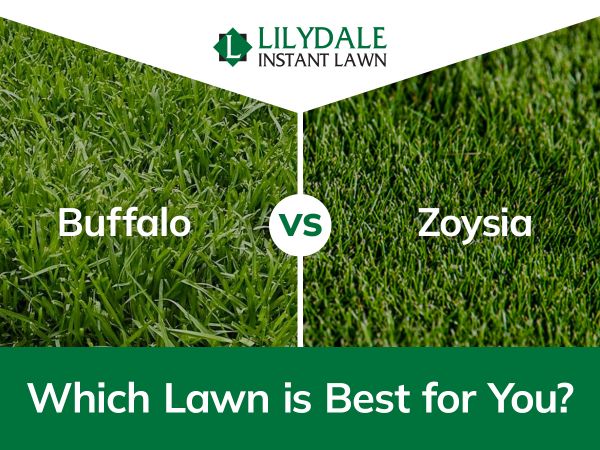When to fertilise existing and new lawn
Fertilising your lawn at the start of every season (or every 3 months) is a good rule of thumb for a healthy lawn. If you want a slightly more precise routine, you can follow the following schedules:
- Sir Walter every 10 weeks all year round
- Eureka Premium Kikuyu VG in early spring, summer, and autumn
- Tif Tuf the beginning of spring, summer, and autumn
- Sir Grange twice per year
In some cases, additional fertiliser applications can also be used to boost lawn health if your lawn has a specific problem. But you need to be careful not to over-fertilise your lawn.

What type of fertiliser to use
We typically recommend using a granular fertiliser for your regular lawn care schedule. Granular fertiliser will provide consistent, slow-release delivery of nutrients over about an 8-week period. This is its biggest benefit, as it sustains better lawn health in the long term. The long duration of action makes maintaining your fertiliser program easy: all you need to do is apply the correct amount of granular fertiliser for your lawn every 2–3 months.
The Granular Fertiliser we recommend for lawn maintenance is the Lawn Solutions Fertiliser or Oxafert.
Liquid fertilisers can also be helpful in specific circumstances for struggling lawns as it tends to work faster than granular fertiliser, though it doesn’t last as long. Products such as Exceed Liquid Fertiliser can be applied monthly alongside your normal granular fertiliser program to boost grass growth and the general health of your lawn.

How much fertiliser do you need
The average application rate for Lawn Solutions Fertiliser is 2.5kg per 100m2.
It’s essential that you follow your fertiliser's dosing and application instructions to avoid over-fertilising your lawn. Over-fertilising your lawn will cause sudden growth of leaves and thatch. However, this rapid leaf growth is not matched by equivalent root growth, which means you’ll be left with a root system that is unable to supply the lawn with all its water and nutrient needs.
Over fertilising your lawn can also cause a build-up of mineral salt and excess nitrogen, both of which can harm your lawn.
How to do it
- We recommend using a fertiliser drop spreader
- Walk up and back, then across in the opposite direction to get the best coverage
- Once you have applied your fertiliser, sweep any granular or wash any liquid off any hard surfaces to avoid staining
- Finally, water in your fertiliser

When to fertilise existing and new lawn
Fertilising your lawn at the start of every season (or every 3 months) is a good rule of thumb for a healthy lawn. If you want a slightly more precise routine, you can follow the following schedules:
- Sir Walter every 10 weeks all year round
- Eureka Premium Kikuyu VG in early spring, summer, and autumn
- Tif Tuf the beginning of spring, summer, and autumn
- Sir Grange twice per year
In some cases, additional fertiliser applications can also be used to boost lawn health if your lawn has a specific problem. But you need to be careful not to over-fertilise your lawn.

What type of fertiliser to use
We typically recommend using a granular fertiliser for your regular lawn care schedule. Granular fertiliser will provide consistent, slow-release delivery of nutrients over about an 8-week period. This is its biggest benefit, as it sustains better lawn health in the long term. The long duration of action makes maintaining your fertiliser program easy: all you need to do is apply the correct amount of granular fertiliser for your lawn every 2–3 months.
The Granular Fertiliser we recommend for lawn maintenance is the Lawn Solutions Fertiliser or Oxafert.
Liquid fertilisers can also be helpful in specific circumstances for struggling lawns as it tends to work faster than granular fertiliser, though it doesn’t last as long. Products such as Exceed Liquid Fertiliser can be applied monthly alongside your normal granular fertiliser program to boost grass growth and the general health of your lawn.

How much fertiliser do you need
The average application rate for Lawn Solutions Fertiliser is 2.5kg per 100m2.
It’s essential that you follow your fertiliser's dosing and application instructions to avoid over-fertilising your lawn. Over-fertilising your lawn will cause sudden growth of leaves and thatch. However, this rapid leaf growth is not matched by equivalent root growth, which means you’ll be left with a root system that is unable to supply the lawn with all its water and nutrient needs.
Over fertilising your lawn can also cause a build-up of mineral salt and excess nitrogen, both of which can harm your lawn.
How to do it
- We recommend using a fertiliser drop spreader
- Walk up and back, then across in the opposite direction to get the best coverage
- Once you have applied your fertiliser, sweep any granular or wash any liquid off any hard surfaces to avoid staining
- Finally, water in your fertiliser




















